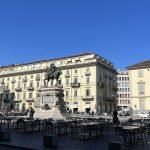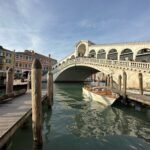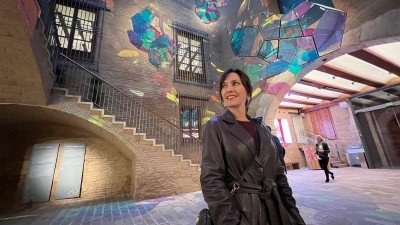For Prosecco enthusiasts, opportunities to drink up the culture and sample this Italian sparkling wine at its source reside along Prosecco Road, about a half-hour’s drive north of Venice. The 25-mile paved byway known as “Strada del Vino” winds through a patchwork of terraced vineyards, growing glera or prosecco grapes at the base of the Italian Alps in the Conegliano Valdobbiadene wine region encompassing 15 mountain municipalities.

The prosecco-growing town of Conegliano, in the province of Treviso, is home to Italy’s first school of Onelogy, which opened in 1876, where winemakers learned to harness the region’s rugged terrain and many micro-climates to produce world-class sparkling wine, including the Grand Cru known as Cartizze.

For wine growers, cultivating and harvesting the grapes is demanding physical labor because they handpick the grapes, navigating slopping terrain, a labor-intensive process, earning the region a UNESCO World Heritage Site designation in 2019. UNESCO describes this area between the Dolomite mountains and the Adriatic Sea as a “hogback,” a geomorphic configuration consisting of steep hills of terraced vineyards stretching east to west with small valleys running parallel.

Valdobbiadene: The Heart of Prosecco
Vineyards in the Conegliano Valdobbiadene wine region produce prosecco adhering to strict standards, noted by the designation DOCG (Denomination of Origin Controlled and Guaranteed). The light-bodied, crisp sparkling wine is famous worldwide for its affordability and mixability as the primary ingredient in an Aperol Spritz. The bubby pinkish-orange concoction is Italy’s favorite alcoholic beverage, a mix of prosecco and the bitter Aperol or Campari.

The Wineries of Prosecco Road
The pinnacle of prosecco comes from Cartizze, a small hill in the municipality of Valdobbiadene, known as prosecco’s birthplace. Cartizze is a best-in-class Italian sparkling wine and a wine subzone of approximately 250 acres with about 140 winegrowers. The Cartizze label carries the designation Valdobbiadene Prosecco DOCG Superiore di Cartizze, signifying its grapes are vinified only within the municipality of Valdobbiadene. Cartizze is a dry sparkling wine with little sugar and limited production and availability.
As a prosecco aficionado, I wanted to meet some of the makers of the best-in-class of Italian prosecco, learn about their process, and drink prosecco at its origins while overlooking breathtaking vineyard vistas.

I visited Garbara Vineyards, a fifth-generation sparkling winemaker specializing in Cartizze Prosecco. Owner Mirco Grotto explains that the Cartizze sub-area where Garbara resides has ideal conditions to produce the highest quality prosecco. Cartizze’s unique micro-climate of alternating high and low temperatures, mineral-rich soil, constant ventilation from mountain winds, and southern sun exposure for balanced ripening produce contribute to this world-class prosecco.

Garbara says it’s the first winemaker to produce the Cartizze with the traditional method known as the Martinotti-Charmat method, which involves the addition of yeasts into steel tanks for fermentation. Garbara ferments its proseccos for four months to yield a lower sugar content than most proseccos. Mirco explains that most wines ferment for five or six weeks; however, the longer the fermentation, the lower the sugar content. Garbara produces 30 thousand bottles a year.
The Garbara Cartizze I tasted had zero sugar. I also sampled a Prosecco Superiore, Extra Brut, which has from zero to five grams of sugar per liter. Prosecco Superiore DOCG typically has a straw yellow color, an 11 percent alcohol content, and is differentiated by its sugar content. I learned that Brut is the driest style containing 0 to 12 grams of sugar per liter. Extra Dry is the most traditional version, with 12 to 17 g/l, and Dry has a higher residual sugar level from 17 to 32 g/l.

Not to be confused with Champagne, produced in the Champagne region of France using a secondary fermentation in the bottle to create bubbles, Italian prosecco is a sparkling wine produced exclusively in Northeast Italy in Veneto, and Friuli Venezia Giulia, another area for prosecco production. Friuli Venezia Giulia resides in a flat valley that encompasses nine provinces. Vineyards in this region can mechanically harvest the grapes, thereby reducing the cost of production.

Italian prosecco is popular for its affordability and clean, fresh taste, straw yellow color, persistent perlage (bubbles), and aromas of white flowers, apple, and pear.

Next, I head to The Ca’ Salina Winery atop a hill in the heart of the Valdobbiadene DOCG area overlooking a rolling mosaic of steep slopping vineyards. The Ca’ Salina family villa welcomes visitors with a tasting room and shop.
Riccardo Bortolin founded the Ca’ Salina Winery in the 1970s. In 1993, Gregorio Bortolin built his winery inside the hill behind the house. The winery offers prosecco tastings outdoors, overlooking the picturesque views.

How Italian Prosecco is made:
Prosecco producers in this region typically use the Charmat method of fermentation, first in stainless steel tanks followed by a second fermentation in large pressurized tanks called autoclaves to produce bubbles. Prosecco is made predominantly from glera grapes, but the regulations permit up to 15 percent of other approved grape varieties to be used.
The process begins with winemakers or oenologists pressing the glera grapes to extract the must, then they filter and clarify the must. Next, they add yeast to activate alcoholic fermentation in stainless steel tanks and monitor the temperature, pressure, and wine properties daily. After oenologists have tasted the wine to evaluate the vintage and determine the coupage, the wine moves to the sparkling phase in the autoclave. This secondary fermentation forms the perlage, the bubbles inside the glass that rise to the surface forming patterns. Perlage is a mark of quality with Prosecco.
What is the difference between Champagne and Prosecco?
Champagne and other sparkling wines typically get their bubbles when they undergo a second fermentation with added sugar and yeast. The yeast feeds on the sugar and converts into alcohol and carbon dioxide. Champagne’s second fermentation process occurs in the bottle, a more time-consuming and expensive process. Prosecco’s second fermentation happens in large quantities in pressurized autoclaves or tanks rather than in individual bottles, as with Champagne.
How to identify a Conegliano Valdobbiandene Prosecco Superiore:
The region of Conegliano Valdobbiadene ranks as Italy’s highest designation for wine regions, known as DOCG. Every bottle of Conegliano Valdobbiandene Prosecco Superiore must have the state label on its neck as a guarantee of quality and authenticity. Prosecco DOCG must be written on the front label and Product of Italy on the back.
To recognize a Conegliano Valdobbiandene Prosecco Superiore, it’s essential to read the label, which has the name of the region Conegliano Valdobbiandene, followed by the word Prosecco, the designation, Superiore and the word “Rive” with the subzone and the vintage year of the harvest.
The wine must be made with a minimum of 85% glera or prosecco grapes. Additional geographical indications for Italian prosecco pertain to where they are produced, including a brown seal for traditional hills and blue seals for newer wine provinces.
How to drink Italian Prosecco:
To enjoy an Italian Prosecco’s full flavors and notes, drink it from a tulip-shaped glass at 6-8°C (43-47°F).
What to know if you go:
You can book a day trip tour from Venice of wineries along Prosecco Road. Some tours offer all-inclusive rates to visit multiple wineries between Conegliano and Valdobbiadene and sample prosecco with local cuisine.
Bassano del Grappa is one of the nearest towns to the prosecco region, full of its own charms, including its claim to fame as the birthplace of Grappa, an Italian aperitif.

While exploring Prosecco Road, I stayed at the lovely Stella Alpina Bed and Breakfast in Conco, located between the towns of Bassano del Grappa and Asiago.

The owner of Stella Alpina cooks up breakfast each morning, which is a culinary event— sweet, savory and made with locally grown ingredients.

Other nearby towns offer comfortable, convenient and stylish accommodations to explore the prosecco-producing region.
You can get to Prosecco Road by flying into the Venice airport, which is located 32 miles from Congeliano.
For more affordable car rental rates, I suggest renting a car from a local resident, as opposed to renting from the airport. You can search local rentals from the company GetRentACar.com
Editor’s Note:
Special thanks to Marco Ferrin and his extended Ferrin family for sharing their culture, community, favorite places and insights throughout my travels in Northern Italy. As a longtime local family in the Northeastern mountain communities of Italy, the Ferrin family has deep roots and vast knowledge of the region.

Some links in this post contain affiliate links. Meaning if you click through and make a purchase, I may earn a small commission at no additional cost to you. Your support means a lot to me and helps me to keep creating and maintaining the quality of this site for you.



































